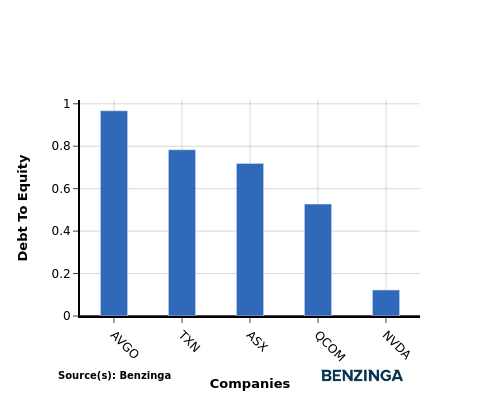Market Analysis: NVIDIA And Competitors In Semiconductors & Semiconductor Equipment Industry
In the ever-evolving and intensely competitive business landscape, conducting a thorough company analysis is of utmost importance for investors and industry followers. In this article, we will carry out an in-depth industry comparison, assessing NVIDIA (NASDAQ:NVDA) alongside its primary competitors in the Semiconductors & Semiconductor Equipment industry. By meticulously examining key financial metrics, market positioning, and growth prospects, we aim to offer valuable insights to investors and shed light on company's performance within the industry.
NVIDIA Background
Nvidia is a leading developer of graphics processing units. Traditionally, GPUs were used to enhance the experience on computing platforms, most notably in gaming applications on PCs. GPU use cases have since emerged as important semiconductors used in artificial intelligence. Nvidia not only offers AI GPUs, but also a software platform, Cuda, used for AI model development and training. Nvidia is also expanding its data center networking solutions, helping to tie GPUs together to handle complex workloads.
| Company | P/E | P/B | P/S | ROE | EBITDA (in billions) | Gross Profit (in billions) | Revenue Growth |
|---|---|---|---|---|---|---|---|
| NVIDIA Corp | 53.88 | 48.58 | 27.82 | 23.01% | $22.58 | $26.67 | 69.18% |
| Broadcom Inc | 101.68 | 18.83 | 23.58 | 7.12% | $8.02 | $10.2 | 20.16% |
| Advanced Micro Devices Inc | 112.93 | 4.33 | 9.11 | 1.23% | $1.59 | $3.74 | 35.9% |
| Texas Instruments Inc | 40.70 | 11.91 | 12.30 | 7.08% | $1.85 | $2.31 | 11.14% |
| Qualcomm Inc | 16.12 | 6.26 | 4.20 | 10.3% | $3.67 | $6.04 | 16.93% |
| ARM Holdings PLC | 208.67 | 24.24 | 41.52 | 3.17% | $0.46 | $1.21 | 33.73% |
| Micron Technology Inc | 19.68 | 2.41 | 3.66 | 3.79% | $4.33 | $3.51 | 36.56% |
| Analog Devices Inc | 63.99 | 3.34 | 11.96 | 1.63% | $1.2 | $1.61 | 22.28% |
| Monolithic Power Systems Inc | 19.20 | 10.55 | 14.66 | 4.17% | $0.18 | $0.35 | 39.24% |
| STMicroelectronics NV | 28.31 | 1.68 | 2.54 | 0.32% | $0.51 | $0.84 | -27.36% |
| ON Semiconductor Corp | 43.37 | 3.25 | 4.02 | -5.78% | $-0.37 | $0.29 | -22.39% |
| ASE Technology Holding Co Ltd | 19.99 | 2.11 | 1.09 | 2.39% | $27.16 | $24.89 | 11.56% |
| First Solar Inc | 15.29 | 2.36 | 4.55 | 2.59% | $0.35 | $0.34 | 6.35% |
| United Microelectronics Corp | 11.57 | 1.39 | 2.27 | 2.06% | $23.86 | $15.45 | 5.91% |
| Credo Technology Group Holding Ltd | 320.45 | 23.40 | 38.54 | 5.63% | $0.04 | $0.11 | 179.73% |
| Skyworks Solutions Inc | 28.66 | 1.85 | 2.99 | 1.11% | $0.22 | $0.39 | -8.87% |
| Qorvo Inc | 151.38 | 2.40 | 2.25 | 0.93% | $0.11 | $0.37 | -7.6% |
| Lattice Semiconductor Corp | 141.89 | 10.20 | 14.85 | 0.71% | $0.02 | $0.08 | -14.68% |
| Universal Display Corp | 31.54 | 4.35 | 11.15 | 3.93% | $0.08 | $0.13 | 0.62% |
| Average | 76.41 | 7.49 | 11.4 | 2.91% | $4.07 | $3.99 | 18.84% |
When conducting a detailed analysis of NVIDIA, the following trends become clear:
-
With a Price to Earnings ratio of 53.88, which is 0.71x less than the industry average, the stock shows potential for growth at a reasonable price, making it an interesting consideration for market participants.
-
The elevated Price to Book ratio of 48.58 relative to the industry average by 6.49x suggests company might be overvalued based on its book value.
-
The stock's relatively high Price to Sales ratio of 27.82, surpassing the industry average by 2.44x, may indicate an aspect of overvaluation in terms of sales performance.
-
The company has a higher Return on Equity (ROE) of 23.01%, which is 20.1% above the industry average. This suggests efficient use of equity to generate profits and demonstrates profitability and growth potential.
-
Compared to its industry, the company has higher Earnings Before Interest, Taxes, Depreciation, and Amortization (EBITDA) of $22.58 Billion, which is 5.55x above the industry average, indicating stronger profitability and robust cash flow generation.
-
The company has higher gross profit of $26.67 Billion, which indicates 6.68x above the industry average, indicating stronger profitability and higher earnings from its core operations.
-
The company's revenue growth of 69.18% exceeds the industry average of 18.84%, indicating strong sales performance and market outperformance.
Debt To Equity Ratio

The debt-to-equity (D/E) ratio gauges the extent to which a company has financed its operations through debt relative to equity.
Considering the debt-to-equity ratio in industry comparisons allows for a concise evaluation of a company's financial health and risk profile, aiding in informed decision-making.
When assessing NVIDIA against its top 4 peers using the Debt-to-Equity ratio, the following comparisons can be made:
-
In terms of the debt-to-equity ratio, NVIDIA has a lower level of debt compared to its top 4 peers, indicating a stronger financial position.
-
This implies that the company relies less on debt financing and has a more favorable balance between debt and equity with a lower debt-to-equity ratio of 0.12.
Key Takeaways
The low P/E ratio suggests that NVIDIA may be undervalued compared to its peers in the Semiconductors & Semiconductor Equipment industry. However, the high P/B and P/S ratios indicate that the market values the company's assets and sales at a premium. On the other hand, the high ROE, EBITDA, gross profit, and revenue growth signify strong financial performance and growth potential relative to industry competitors.
This article was generated by Benzinga's automated content engine and reviewed by an editor.
Posted-In: BZI-IANews Markets Trading Ideas


